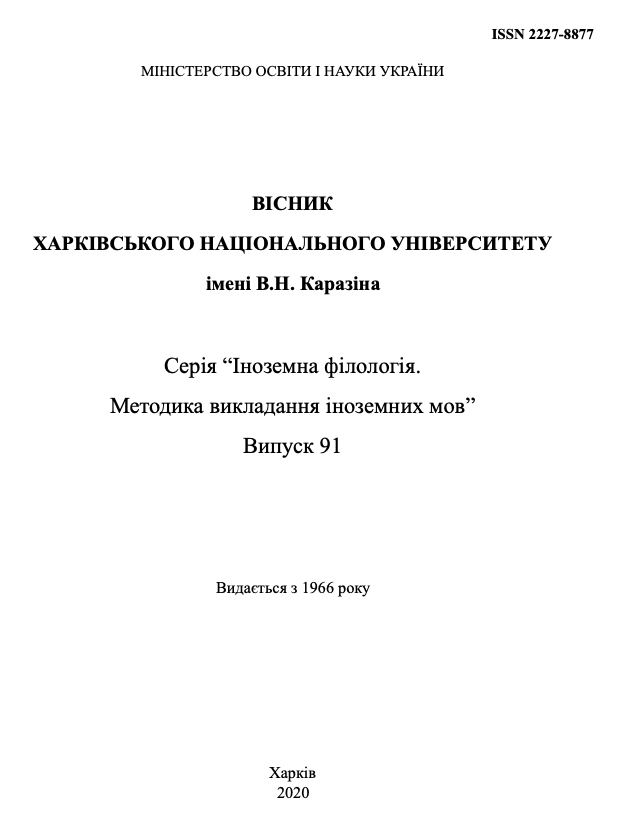Symbolic motivation as one way of displaying culture in language (showcased by French neophraseologisms)
Abstract
This article elucidates the role of symbolic motivation in the creation of the neo-phraseological stock of the French language, which reflects the connection of language units with the culture, history and mentality of its speakers. The author refines the concept of a symbol, which she defines as a sign conveying important information about the specificity of perceiving the world in a certain linguoculture. Among the linguistic symbols that serve as a product and source of culture for the ethno-linguistic community, phraseologisms occupy an important place. After all, they contain a set of features of the cultural stock of a certain ethnic group, verbally represent the universal and national-cultural conceptual image of linguistic consciousness. Analyzing the images and symbols contained in the meaning of the French adjective vert, which is a common component of phraseological units, the author proves that in the course of the development of the French-speaking society, together with its language, the symbol can take on new meanings and serve as the basis for emergence of new collocations. A detailed study of the neophraseologisms of modern French that are underpinned by symbolic motivation has shown that they reflect different associative links with the objects, phenomena and concepts of the surrounding reality of the French socium. In particular, we bear in mind chromatomorphic, substancemorphic, anthropomorphic, floromorphic, naturomorphic, chronomorphic associations. As a result, the author states that the symbol exists in the collective consciousness of the French ethnic group, reveals its content due to the action of many linguistic and non-linguistic factors that determine its understanding by all members of a particular society. Awareness of the nature of the close interconnection and interdependence of the linguistic and cultural spheres, makes it possible to bring to light manifestations of culture in language and the motivation of its senses in linguistic units, as well as specific spheres of language use in which it captures the achievements of culture.
Downloads
References
Babushkin, A. P. (1996) Tipy kontseptov v leksiko-frazeologicheskoy semantike yazyika [Types of concepts in the lexical and phraseological semantics of the language]. Voronezh: Izd-vo Voronezh. gos. un-ta. [In Russian]
Belov, E. A. (2014) Artefakt kak strukturnaya edinitsa kulturyi [Artifact as a structural unit of culture]. [PhD Thesis]. Tyumen. Available at: www.tmnlib.ru/jirbis/files [In Russian]
Bragina, N. G. (2007) Pamyat v yazyike i culture [Memory in language and culture]. Moskva: Yazyiki slavyanskih kultur. [In Russian]
Vereschagin, E. M., Kostomarov, V.G. (1982) Natsionalno-kulturnaya semantika russkih frazeologizmov [National-cultural semantics of Russian phraseological units]. Dictionaries and linguistic studies. Moskva: Russkiy yazyik, pp. 89–98. [In Russian]
Hladka, V. (2018) Neofrazeolohizatsiia suchasnoi frantsuzkoi movy: linhvokohnityvnyi aspekt: u 2 ch. [Neophrasologization of modern French: linguocognitive aspect: 2 ch.]. Chernivtsi: Tekhnodruk, 2018. Ch. 1. Monohrafiia. 680 p. [In Ukrainian]
Karakevych, R. O. (2014) Linhvokulturolohichne doslidzhennia frazeolohizmiv-linhvokulturem [Linguocultural study of phraseologisms-linguoculture]. Scientific Bulletin of I. Franko State Pedagogical University. Series “Philological Sciences”. Linguistics. № 2, pp. 58–62 [In Ukrainian]
Kovshova, M. L. (2012) Lingvokulturologicheskiy metod vo frazeologii: Kodyi kulturyi: monografiya. [Linguoculturological method in phraseology: Culture codes: monograph]. Moskva: Knizhnyiy dom “LIBRIKOM”. [In Russian]
Kopchuk, L. B. (2000) Frazeologizmyi kak znaki-indikatoryi kulturno-yazyikovoy kompetentsii nositeley yazyika. [Phraseologisms as signs-indicators of the cultural and linguistic competence of native speakers]. Problems of idio-ethnic phraseology. Sankt-Peterburg: Izd-vo RGPU imeni A.I. Gertsena, pp. 42–49. [In Russian]
Metafora v yazyike i tekste (1988) [Metaphor in language and text] [otv. red. V.N. Teliya]. Moskva. [In Russian]
Morozova, V. S. (1999) Simvolika tsvetooboznacheniya pri opisanii kontseptov emotsiy v sovremennom arabskom literaturnom yazyike [Symbolism of color designation in the description of the concepts of emotions in modern Arabic literary language]. Phraseology in the context of culture. Moskva: Yazyiki russkoy kulturyi, pp. 300–304. [In Russian]
Potebnya, A. A. (1989) Slovo i mif [Word and myth]. Moskva. [In Russian]
Selivanova, O. O. (2008) Suchasna linhvistyka: napriamy ta problemy: pidruchnyk [Modern linguistics: directions and problems: a textbook]. Poltava: Dovkillia-K. [in Ukrainian]
Stepanova, O. V. (2002) Kulturologicheskiy aspekt frazeologii frantsuzskogo argo [Culturological aspect of the phraseology of French argo]. [PhD Thesis]. Moskva. Available at: www.disser_cat-com [In Russian]
Tarasov, E. F. (1994) Yazyik i kultura. Metodologicheskie problemyi. [Language and culture. Methodological problems]. Language, culture, ethnos. Moskva, pp. 105–112. [In Russian]
Teliya, V. N. (1996) Russkaya frazeologiya. Semanticheskiy, pragmaticheskiy i lingvokulturologicheskiy aspektyi. [Russian phraseology. Semantic, pragmatic and linguocultural aspects]. Moskva: Shkola “Yazyiki russkoy kulturyi”. [In Russian]
Tokarev, G. (2005) Otrazhenie etalonov russkoy kulturyi v znacheniyah etiketnyih vyirazheniy. [Reflection of the standards of Russian culture in the values of etiquette expressions]. Facets of the word: scientific articles for the 65th anniversary of prof. V.M. Mokienko. Moskva: ELPIS, pp. 489–494. [In Russian]
Toporov, V. N. (1995) Mif. Ritual. Simvol. Obraz: issledovaniya v oblasti mifopoeticheskogo: Izbrannoe. [Myth. Ritual. Symbol. Image: Mythopoetic Studies: Favorites]. Moskva: Izdatgruppa “Progress” – “Kultura”. [In Russian]
Yung, K. G. (2006) Psihologicheskie tipyi [Psychological types]. Moskva. [In Russian]
Dictionnaire de l’Académie française, 9-ème éd. (2010) Available at : http://artfl.atilf.fr/dictionnaires/ACADEMIE/index.htm
Galisson, R. (1991) De la langue à la culture par les mots. Paris : Edition CIE International.
Pastoureau, M. (2013) Vert, histoire d’une couleur. Paris : Seuil.




